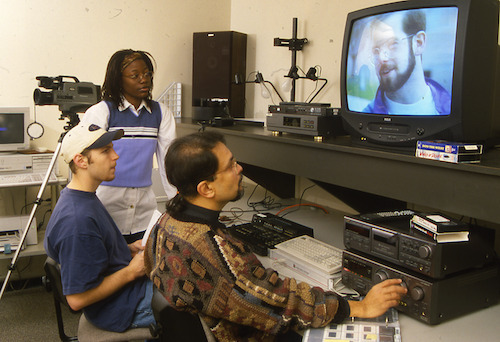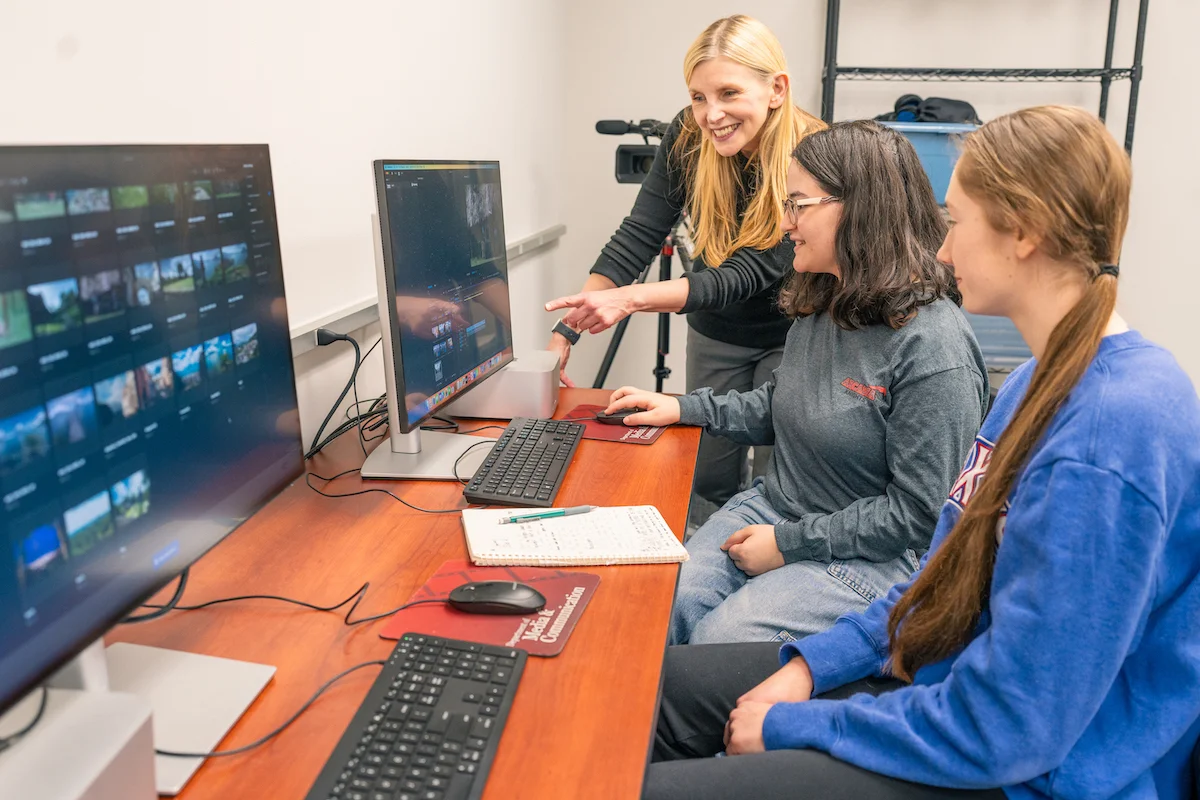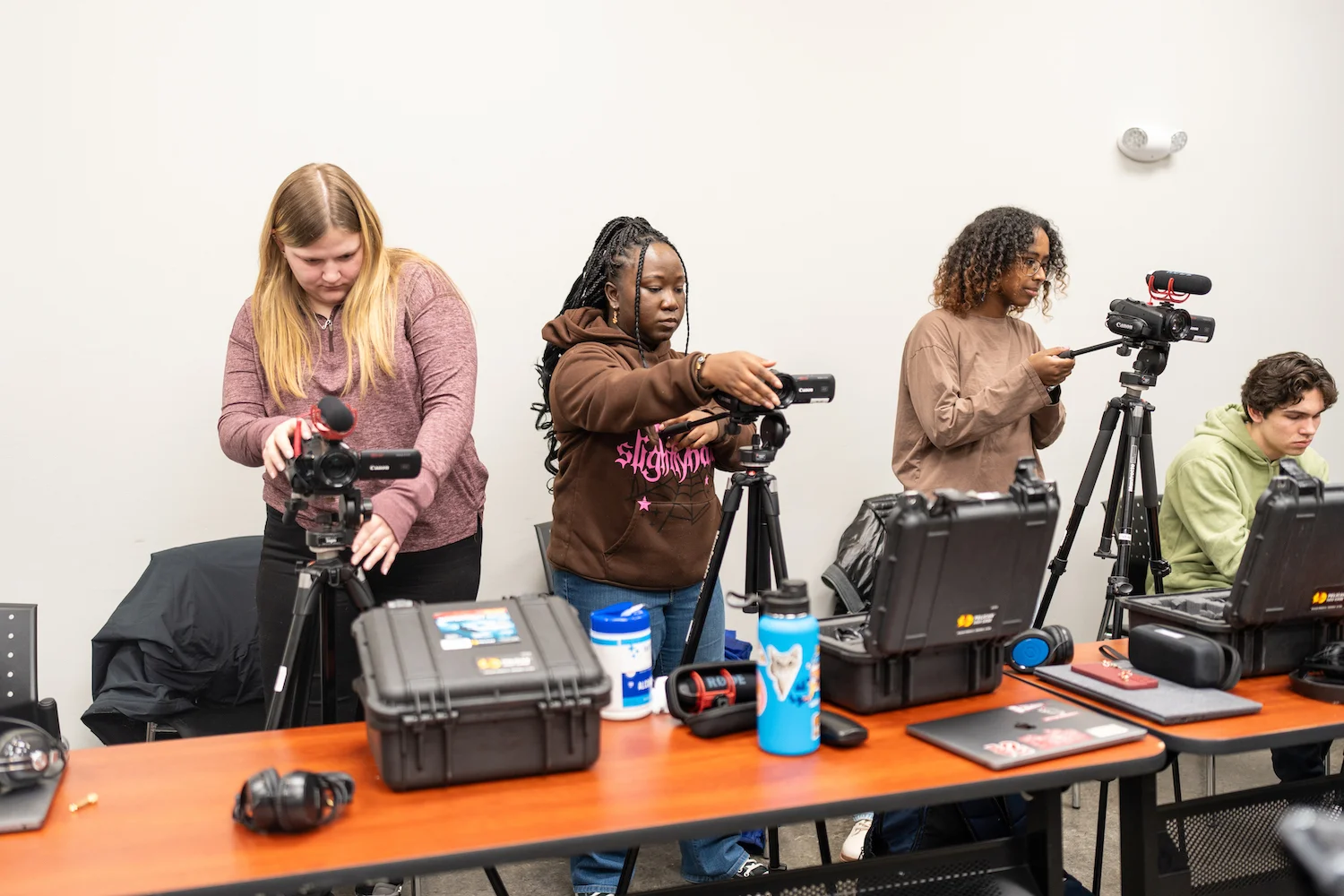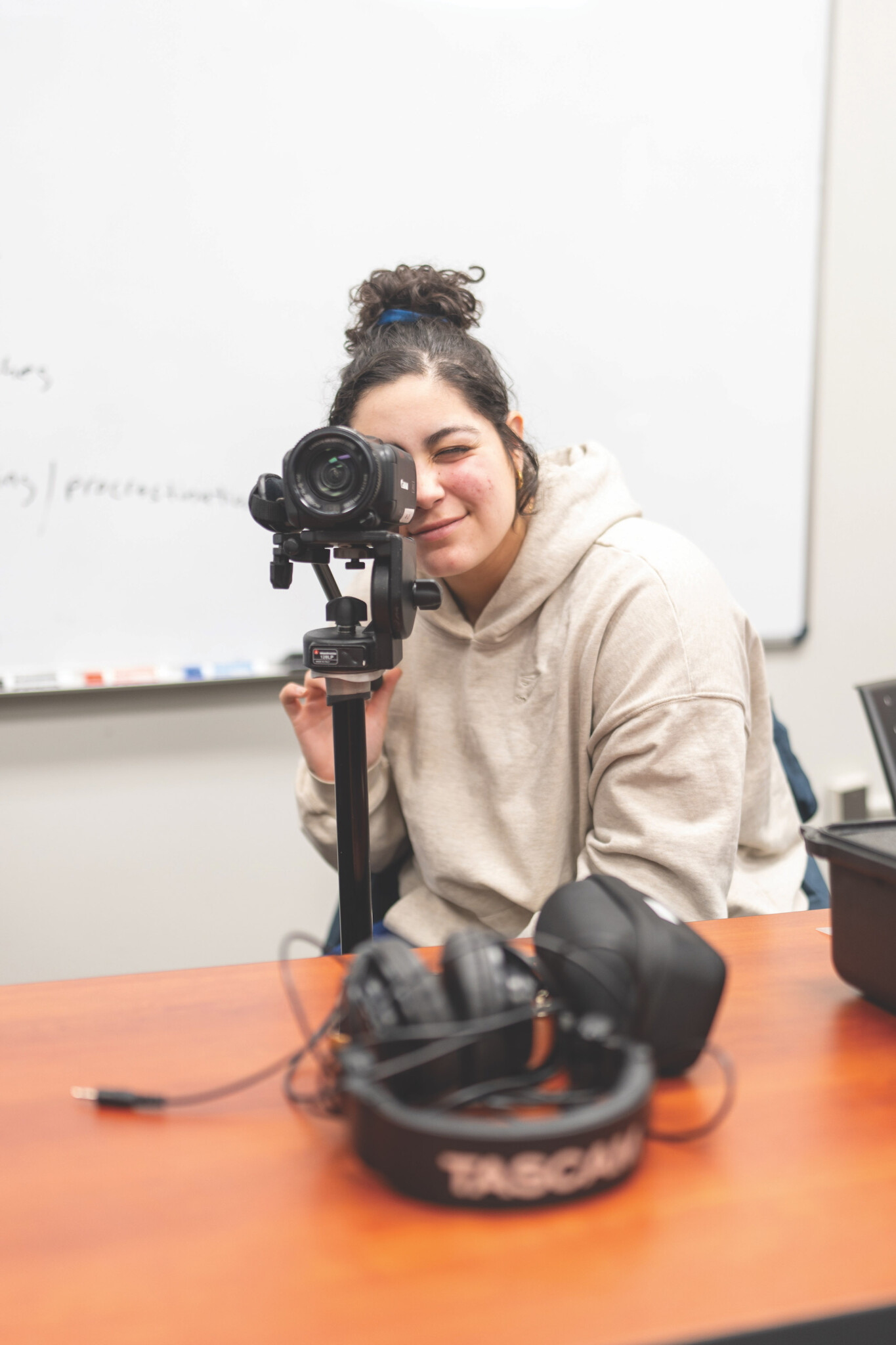Arcadia Magazine Spring 2024: Just Like Punk Rock: Teaching and Learning Media and Communication in the Digital Age
In 1988, Dr. Shekhar Deshpande started a communications segment of the Beaver College English department program called English, Theater, and Communication with a single camera and VCR in a room on the second floor of Murphy Hall. To assist students in their future careers, he’d invite artists and filmmakers from places as far as Hungary, India, and Hong Kong through his networks to visit campus and speak to students.
Dr. Deshpande held screenings in Stiteler Auditorium for students and the community. These events drew in new attendees each week and gained notoriety through The Philadelphia Inquirer’s weekend section.
Three years later, Dr. Deshpande planned a screening of David Lynch’s Twin Peaks, leading to the release of the show’s finale. With no DVR and no streaming, Dr. Deshpande taped the broadcasts of each episode on VHS. Stiteler Auditorium was one of the only places on campus where fans could watch the show in a theater-like setting.
“The Inquirer sends one of their top reporters,” he said, recounting the night of the screening. “But what we didn’t anticipate was that my wife was giving birth that evening. So, we were in a hospital, and the reporter was on campus describing everything for her story. The auditorium was full. We got massive publicity because of it.”
In addition to arranging screenings, Dr. Deshpande’s personal and professional efforts helped to forge an entire department out of that budding English, Theater, and Communication program. As founding chair, he increased enrollment and recruited faculty to kickstart the Global Media program. This made the program more distinctive, setting an example of what a modern Media and Communication department can be.
Today, 77 students are enrolled in the Department of Media and Communication’s two undergraduate major programs, Media and Communication and Global Media (see sidebar on pg. 30), each of which offers unique concentrations to best suit students’ desired areas of study. The department also offers minors in World Cinema and Cinema Studies. Each program works to provide students with a balance of both theory and practice, allowing them to fully understand the ideological systems of media and communication as well as the work that goes into those systems.


Mass Consumption of Media
In most disciplines, the specifics of what students learn vary and evolve; this dynamic is amplified in media. The rapid nature of social media forces trends to rise and fall in popularity within a week – at times within a day. In film and music, the sheer amount of content that is released regularly segments audiences into genres that are also branching out and splintering.
In addition, the number of methods by which students receive information and communicate has increased exponentially. Students absorb new information at nearly every waking moment, whether that be by passively scrolling through Instagram and TikTok or by actively seeking out specific content.
Mass amounts of content being published daily have forced audiences to grow segmented, where consumers may enjoy little beyond their preferred tastes. This has to be factored in when teaching.
“Ten, 15 years ago, I felt like I could use examples in class that most people had heard of,” said Dr. Chris Mullin ’20Ed.D., assistant professor of Media and Communication. “While that is still true, the audiences have become so fragmented and segmented that it’s hard sometimes to relate a lot of media things to everybody in the room.”
Dr. Michael Dwyer, associate professor of Media and Communication and program director of Global Media, agreed that background information students bring into the major before they begin their studies is vastly different than it was in the past.
“In my 101 [Intro to Media Studies] class right now, I find myself needing to explain what a television network is, which when I started teaching, people just knew. NBC, and how is something like Disney+ different from that?” said Dr. Dwyer.
These adjustments to the core curriculum may not be seen by students directly, but there are glimpses of their learning’s practicality in their daily lives. Intro to Media Studies forms the base on which the rest of the major is built, making the knowledge provided paramount to the student experience in the program, even while students are abroad.
Jake Smith ’24, a Global Media major with a concentration in Sound and Music, described the adequacy of this foundation and its importance while he studied abroad. Alongside his studies at the University of Technology Sydney in Australia, he interned with a company that works to set up audio, visual, and structural elements for small and large events in Sydney.
“I’ve learned so much in the classroom, all of which I still use in some way today,” he said. “Between the topics discussed in class or the methods used for my assignments, they have maintained relevance and an ability to apply to the things I do and conversations I have.”
Each professor has their way of staying on top of the daily happenings in media, from Dr. Mullin’s use of the daily Public Relations Society of America (PRSA) newsletter to Dr. Deshpande’s use of TikTok to view one-minute short films from the Cannes Film Festival. Ultimately though, the best way for them to keep in touch with expanding media is to remain connected with students.
The final project in Intro to Media Studies asks students to write about a new media service and compare it to one of the past. Dr. Dwyer credits this as an aid to his understanding of current media. He discusses connections between older and newer media services with students, connecting with them while sharing new interpretations of media.

Punk Rock Ethics
From team podcasting to individual essays, the Media and Communication department continues to widen the modalities by which students can complete assignments. This not only gives them experience producing various types of media, but also helps them develop confidence in their ability to try new things.
“Honestly, that comes from our ethic of, ‘we can do this,’” Dr. Dwyer said. “For me, that’s just punk rock. It’s the same for if you were in a band, or if you wanted to start a ‘zine, you can do this. I’m a big believer in, ‘fail early, fail better.’”
“I think that communication is a field that requires a lot of ‘just doing it,’” said Jewel Miller ’24, a Media and Communication major with a concentration in Multimedia Publishing who also serves as the co-editor-in-chief of the online lifestyle magazine Loco Mag. “After practicing in the classroom it’s nice to be able to get hands-on experience to prepare you for a career.”
This professional preparation that Miller references complements the two practicum courses that the department offers: one in publication, where students collaborate on building content and marketing Loco Mag; and the other in public relations, where students work together as members of the 1853 Communications PR firm, collaborating with nonprofit organizations from around the area and compete in the annual Donate Life College Challenge. Both courses are entirely student-led, allowing students to develop the skills they learn in their respective concentrations and gain experience working in real-world settings.
“As a member of Loco Mag, I honed my proofreading skills as well as general communication and project management skills,” said Media and Communication graduate Julie Snider ’22, editor with Kappa Publishing Group. “We also had regular pitch meetings where we shared ideas for book themes, and I don’t think I’d be nearly as comfortable coming up with lists of ideas and sharing them with an entire team if I hadn’t had three years of practice in college.”
Dakota Lewis ’26, a double major in English Literature and Media and Communication with a Multimedia Publishing concentration, is the print edition director for Loco Mag. They lead their team in laying out articles, photos, and other media into a print format using Adobe InDesign before working with a printing service to produce a full-length print magazine each semester.
“Inside the classroom, I’ve learned how to read different forms of media and the processes that lead to the product,” Lewis explained. “Outside of the classroom though, specifically in Loco, I’ve learned a lot about what goes into making media – what editing a podcast looks like, how a magazine is structured online and in
a physical copy, and the filming and editing process for videos.”
Beyond the adaptations to various technologies and new modes of consuming information, the Media and Communication department faculty continues to help students learn what Dr. Mullin calls “soft skills.”
“That ability of teamwork, to be able to get along with people,” said Dr. Mullin. “I think that you learn some of those super important skills through life and other experiences, not just through your schooling.”
The chair of the department, Dr. Lisa Holderman, encourages students to take a wide range of courses in the major. The major requires students to take Writing in Communications and Visual Cultures, but there is a menu of courses for students to learn other skills they won’t find anywhere else.
“Learn some video production, even if that’s not your thing,” said Dr. Holderman, an associate professor of Media and Communication teaching both sections of the senior seminar. “Take some Public Relations courses even if you’re not in the PR concentration. Doing this can help you learn more and get different skills, things that you could use in any job in any field.”
These transferable skills are what Print Communications (now called Multimedia Publishing) alumna Helen Armstrong ’18, professional academic advisor for the College of Media, Communication, and Information at the University of Colorado Boulder, looks back on as key pieces of her education.
“The skills and awareness I gained in the Department of Media and Communication at Arcadia have informed every aspect of my life in very meaningful ways,” she explained. “I’ve done freelance writing on top of my creative writing; I’ve taught writing to kids, college students, and adults; I’ve created writing programs for marginalized youth and adults in my community; I’ve used my communication skills to speak on important topics in my work and personal life. Some of this was facilitated by a job, but most important to me are the values and awareness that I gained as a Communications student which has allowed me to do important things in all areas of life, not just my ‘career.’”

Skepticism, but Never Cynicism
The amount of information that individuals are subjected to daily makes it easy for misinformation to spread, whether through social media posts or mainstream media outlets. A key piece of the Media and Communication department’s curriculum is the ability to deconstruct a message to understand not only what is happening, but also the background, intent, and interests of those who produced it.
“In a world that is now so influenced by news, videos, and social media, having this solid basis of knowledge has made me constantly question the media that comes into my life, who made it, why, what it wants from me as a viewer,” explained Miller ’24. “I can’t help but consciously think about these things all the time now.”
Dr. Dwyer teaches students to be critical and analytical in their deconstruction, but not cynical. He pushes students to substantiate claims, explain reasonings, and engage with doubt not
only in the content they consume and the work they create. Only then, through practice, can students fully recognize and navigate that complexity in their consumption of media.
“I try to model a willingness to not be certain, and try to build skills for distinguishing between skepticism and cynicism, whether it’s in TikTok videos or ‘The Washington Post,’” he said. “It can’t be either ‘I just accept every story in the news’ or ‘nothing’s real.’ Both of those are corrosive; they’re not good for the world.”
Dr. Deshpande emphasized that within the department, the classroom content is immediately relevant to the current world events that influence students’ daily lives. The modalities may have changed from photography to simulated images like deep fakes or work created by artificial intelligence, but that does not alter their global significance.
The department provides a media education encompassing both the modern world students are a part of, and a basis for developing theoretical and historical knowledge within the field. The importance of this approach cannot be understated, as it provides a truly well-rounded experience for students to feel prepared when entering the workforce.
“It’s a responsible way to provide a media education, where the next producers of media understand how it works in the world,” said Armstrong ’18. “You need to allow students to look toward the future but also teach them to look behind them as well, because most of the resources they need will be there. The department absolutely did that for me.”
Sidebar: Global Media Major: A Hidden Gem
Students in the Global Media program get an educational experience that is unique because of Arcadia’s global footprint. A distinguishing feature of the Global Media program is that students spend two semesters abroad at one of our partner institutions, in programs with specific strengths in their course of study. These programs are from top-tier universities in the world for whatever the field of media is.
At the University of Westminster in London, our students are going to a media/journalism/art campus in the global media capital of the UK. Students will walk the hallways of buildings and everybody involved is doing record producing, or they have a student concert venue to practice managing or filming live performances, or there’s a student newsroom, or whatever the case may be.
I did my Ph.D. at Syracuse University, which has a very famous communications school, the Newhouse School. What I saw in just our London partner institutions was the equal of that. So, the special thing about Global Media is that students get their first two years with the liberal arts experience here in Glenside. They have small classes. Their faculty gets to know them. But they also get the advantage of their third year at being at a research institution with enormous facilities and, I can’t undersell this, enormous alumni networks.
Then they come back their senior year, they’re in a major media market in Philadelphia, and they manage a capstone project for themselves. There’s not another university of Arcadia’s size that can offer the things that this Global Media program can. It’s very special, it’s very successful, and it’s also somewhat of a hidden gem.
— Dr. Michael Dwyer, associate professor of Media and Communication and program director of Global Media

